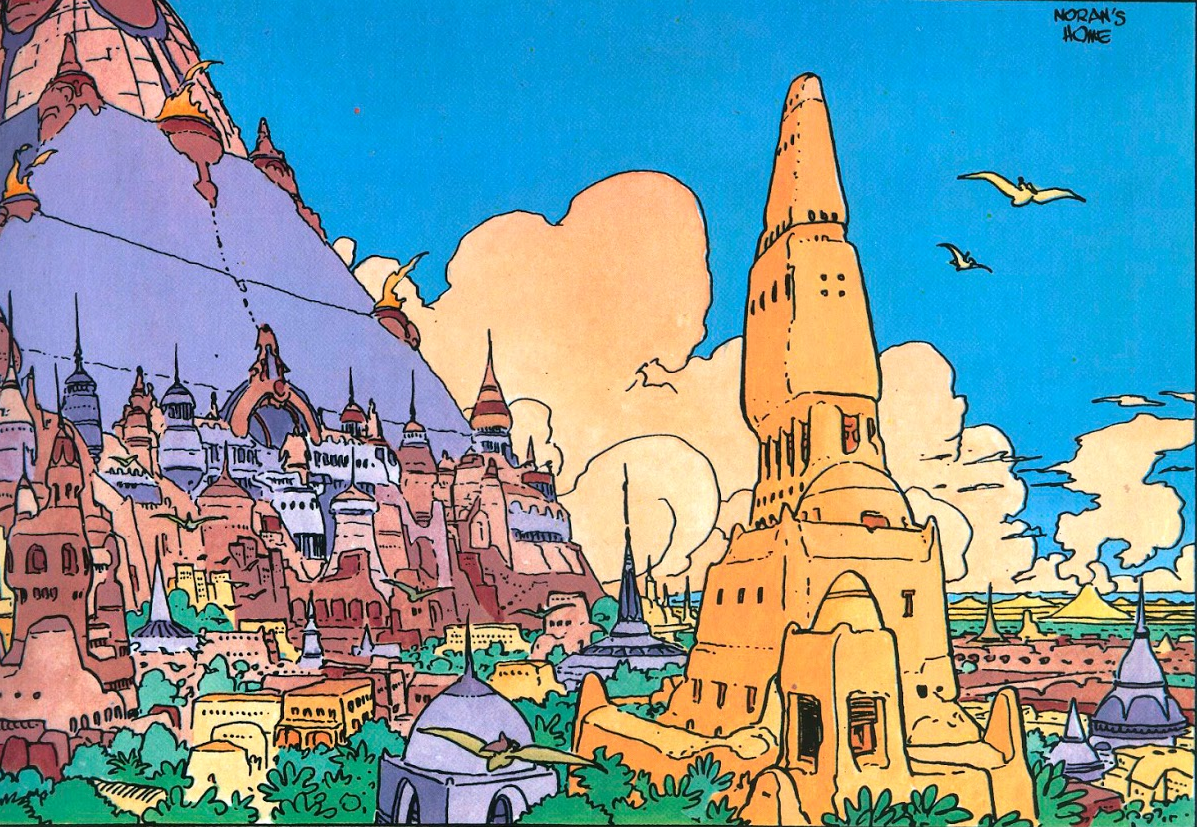6 veteran travelers in Violet City (for UVG)

Long time no see! A couple of recent events slapped me in the face and reminded me that I need to show this blog some more love, so I decided to start posting some materials from my ongoing Ultraviolet Grasslands campaign.
What is this game? A brief explanation
...UVG (Ultraviolet Grasslands) is set on the edge of civilization in the Rainbowlands, a world that conveniently names its various peoples after colors. This civilization is post-apocalyptic, albeit not in a Mad Max sense, but in the sense of being built on top of the ruins of a much older, far more advanced and powerful one.
The Ultraviolet Grasslands are poorly charted lands, visited by caravans and adventurers in search of treasure and strange experiences. These are lands where exoticism takes center stage, sometimes even featuring portals to other worlds—so it wouldn’t be far-fetched to introduce UVG into another existing setting via a portal.
The player characters are part of a caravan venturing into this psychedelic take on the Wild West, in search of riches, wonders, or arcane secrets.
At first, as I mentioned in other posts, I found it quite hard to grasp the internal logic of this world—to make it my own so I could channel it confidently as a GM, without worrying about contradicting something later on in the book. Back then, the characters were still in Violet City, where almost every caravan begins its journey.
Why would the PCs be so reckless as to head into lands they know so little about? What’s really at stake in this expedition? To help myself answer those questions—and to feel more at ease playing with the setting—I created a table of six veteran travelers, mostly retired from the trade, living in Violet City. These are people who once tried to venture West and strike it rich, but for one reason or another ended up returning to this city—the threshold between civilization and a mysterious, opportunity-filled world.
6 Lost Souls of Violet City
Consult this table by rolling a 6 sided die, or simply choose from the list. I like to use this table when the heroes are eating or drinking at a bar, or when they’re wandering through a market or plaza—in general, anytime they don’t have a specific goal and are just exploring. Every one of them has a piece of advice to offer, and if the party gets along with them, they might also provide a useful tip to help navigate a particular route (granting advantage on a misfortune and/or encounter roll).
- Dayuba (L1) works as a neuro‑digitizer on the fringes of Violet City’s Pink Zone. With her astral glove she can slip her arm into your mind through the nape of your neck in order to shake loose old ideas, dredge up fears or memories, or simply deliver pleasure and fantasies. If you chat with her, she’ll tell you how she got greedy during a lucrative raid near the Porcelain Citadel, blew all her winnings on the celebrations afterward, and now pay off lifelong debts by engaging in a trade she despises. Her arm won’t stand many more years of neuro‑digitizing—it’s nearly worn out, too thin.
Using her services counts as taking a drug and grants (1d6 + AURA) × 10 XP, heals 1 point of Aura or Thought, or weeds out and clarifies a trauma‑linked memory, all for a modest $25. - Atakari the dwarf (L4) rolls in on his immense foot‑caravan—a giant foot (which once belonged to a colossus) animated by some blend of biomancy or golemancy, onto which he’s bolted wooden structures so it can trundle across the grasslands. He will pay the party $30 for a few hours of heavy labor. When not working or travelling, Atakari drinks quietly at Sheh Shah.
If asked, he advises the heroes to find a safe route and stick to it: “Our first life is the most precious—don’t waste it.” He also warns them to be extremely cautious when picking those they will trust.
Atakari grows nervous and changes the subject if pressed about how he acquired the colossus foot. He definitely didn’t murder his allies to keep the loot—and the foot—found at the Fallen Umber. - Silecio D’Argent (L2, depressed) and his cat Oculus (L1, emotional vampire) almost live on the street, bouncing from one shelter to another. If you buy him a few beers, Silecio will tell you that the grasslands are a capricious god that gives nothing without demanding something in return. A former dryland coral artisan, he went west seeking fortune and riches—but in an accident near the Near Moon, his arm detached and walked away, leaving him behind. Silecio has his own theories: he says his soul was split in that moment.
He advises the heroes not to use magic. - Vargas the Untamed (L2, wrathful) lost his companions in a disastrous expedition. Since then, he works solo as a hired thug and hasn’t spoken to his sister Migo in years. He’s hooked on Purple Haze (a drug), and offers this advice: “Don’t love anyone too much—you could lose them in an instant to a cloud of Bahamuth’s ectoplasmic gas” (in the South‑Facing Passage).
- Lveka, the Discordant Mathematician (L3, lunatic methodist), is a crazy old woman with 1d4 cats, tangled hair, and a tendency to speak nonsense—except for brief flashes of clarity. Her life’s goal was to prove the mathematical theory of discordance, which holds that this world is flawed, and that its design errors can be corrected. She claims that after years of preparation, she reached the mythical Black City, where its balanced architecture, immaculate physics, and cruel symmetries shattered her theoretical framework and plunged her into depression. No one takes her ravings seriously, but Lveka warns: “At the end of the road, if you’re ambitious, only disappointment awaits.”
- Doñ Sandwich Trigenary (L4, polyamorous) is an unmasked entity composed of three bodies, now spending by chance their final days in Violet City before circling the Circular Sea on a new journey. Doñ Sandwich’s duality began their travels from the Last Serai, feeling incomplete and lacking something.
“We found our missing third,” they say, “in the valley of the Near Moon. We danced, synchronized, and integrated willingly—and chose to shed our masks.”
Their advice is to know when to step away, and to resist the temptation of endlessly chasing fortune.
If you’d like an easy-to-print version of this table, you can subscribe to the Astrofork newsletter to download it as a free PDF and use it in your games. You can also read more about Ultraviolet Grasslands in this selection of my articles, or check out and purchase the game. Until next time!!
